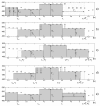A novel technique for fetal heart rate estimation from Doppler ultrasound signal
- PMID: 21999764
- PMCID: PMC3305903
- DOI: 10.1186/1475-925X-10-92
A novel technique for fetal heart rate estimation from Doppler ultrasound signal
Abstract
Background: The currently used fetal monitoring instrumentation that is based on Doppler ultrasound technique provides the fetal heart rate (FHR) signal with limited accuracy. It is particularly noticeable as significant decrease of clinically important feature - the variability of FHR signal. The aim of our work was to develop a novel efficient technique for processing of the ultrasound signal, which could estimate the cardiac cycle duration with accuracy comparable to a direct electrocardiography.
Methods: We have proposed a new technique which provides the true beat-to-beat values of the FHR signal through multiple measurement of a given cardiac cycle in the ultrasound signal. The method consists in three steps: the dynamic adjustment of autocorrelation window, the adaptive autocorrelation peak detection and determination of beat-to-beat intervals. The estimated fetal heart rate values and calculated indices describing variability of FHR, were compared to the reference data obtained from the direct fetal electrocardiogram, as well as to another method for FHR estimation.
Results: The results revealed that our method increases the accuracy in comparison to currently used fetal monitoring instrumentation, and thus enables to calculate reliable parameters describing the variability of FHR. Relating these results to the other method for FHR estimation we showed that in our approach a much lower number of measured cardiac cycles was rejected as being invalid.
Conclusions: The proposed method for fetal heart rate determination on a beat-to-beat basis offers a high accuracy of the heart interval measurement enabling reliable quantitative assessment of the FHR variability, at the same time reducing the number of invalid cardiac cycle measurements.
Figures











Similar articles
-
An open source autocorrelation-based method for fetal heart rate estimation from one-dimensional Doppler ultrasound.Physiol Meas. 2019 Feb 26;40(2):025005. doi: 10.1088/1361-6579/ab033d. Physiol Meas. 2019. PMID: 30699403 Free PMC article.
-
New Method for Beat-to-Beat Fetal Heart Rate Measurement Using Doppler Ultrasound Signal.Sensors (Basel). 2020 Jul 22;20(15):4079. doi: 10.3390/s20154079. Sensors (Basel). 2020. PMID: 32707863 Free PMC article.
-
Comparison of doppler ultrasound and direct electrocardiography acquisition techniques for quantification of fetal heart rate variability.IEEE Trans Biomed Eng. 2006 May;53(5):855-64. doi: 10.1109/TBME.2005.863945. IEEE Trans Biomed Eng. 2006. PMID: 16686408 Clinical Trial.
-
Doppler Ultrasound Technology for Fetal Heart Rate Monitoring: A Review.IEEE Trans Ultrason Ferroelectr Freq Control. 2020 Feb;67(2):226-238. doi: 10.1109/TUFFC.2019.2943626. Epub 2019 Sep 25. IEEE Trans Ultrason Ferroelectr Freq Control. 2020. PMID: 31562079 Review.
-
Monitoring the fetal heart non-invasively: a review of methods.J Perinat Med. 2001;29(5):408-16. doi: 10.1515/JPM.2001.057. J Perinat Med. 2001. PMID: 11723842 Review.
Cited by
-
Evaluation of a Portable Doppler Ultrasound Gating Device for Fetal Cardiac MR Imaging: Initial Results at 1.5T and 3T.Magn Reson Med Sci. 2018 Oct 10;17(4):308-317. doi: 10.2463/mrms.mp.2017-0100. Epub 2018 Feb 21. Magn Reson Med Sci. 2018. PMID: 29467359 Free PMC article.
-
The Design and Implementation of Cardiotocography Signals Classification Algorithm Based on Neural Network.Comput Math Methods Med. 2018 Dec 3;2018:8568617. doi: 10.1155/2018/8568617. eCollection 2018. Comput Math Methods Med. 2018. PMID: 30627211 Free PMC article.
-
Cardiotocography in Obstetrics: New Solutions for "Routine" Technology.Sensors (Basel). 2022 Jul 8;22(14):5126. doi: 10.3390/s22145126. Sensors (Basel). 2022. PMID: 35890806 Free PMC article.
-
An open source autocorrelation-based method for fetal heart rate estimation from one-dimensional Doppler ultrasound.Physiol Meas. 2019 Feb 26;40(2):025005. doi: 10.1088/1361-6579/ab033d. Physiol Meas. 2019. PMID: 30699403 Free PMC article.
-
Non-Adaptive Methods for Fetal ECG Signal Processing: A Review and Appraisal.Sensors (Basel). 2018 Oct 27;18(11):3648. doi: 10.3390/s18113648. Sensors (Basel). 2018. PMID: 30373259 Free PMC article. Review.
References
-
- Jezewski J, Wrobel J, Horoba K, Cholewa D, Gacek A, Kupka T, Matonia A. Monitoring of mechanical and electrical activity of fetal heart: The nature of signals. Arch Perinat Med. 2002;8:40–46.
-
- Matonia A, Jezewski J, Kupka T, Wrobel J, Horoba K, Widera M. Instrumentation for fetal cardiac performance analysis during the antepartum period. Conf Proc IEEE Eng Med Biol Soc. 2005;27:6675–6678. - PubMed
Publication types
MeSH terms
LinkOut - more resources
Full Text Sources
Other Literature Sources
Medical

